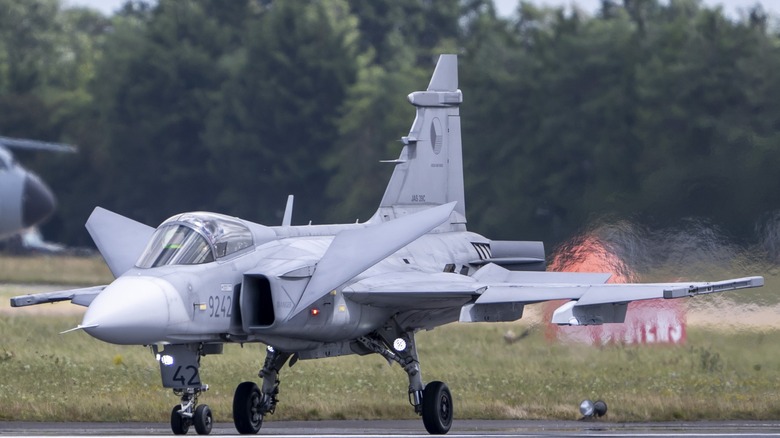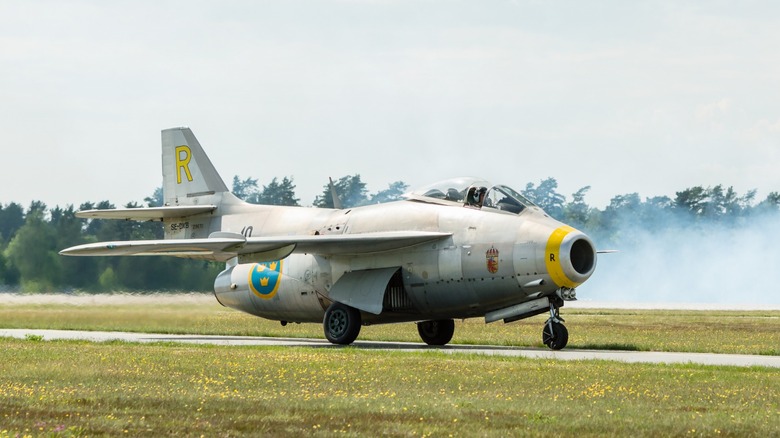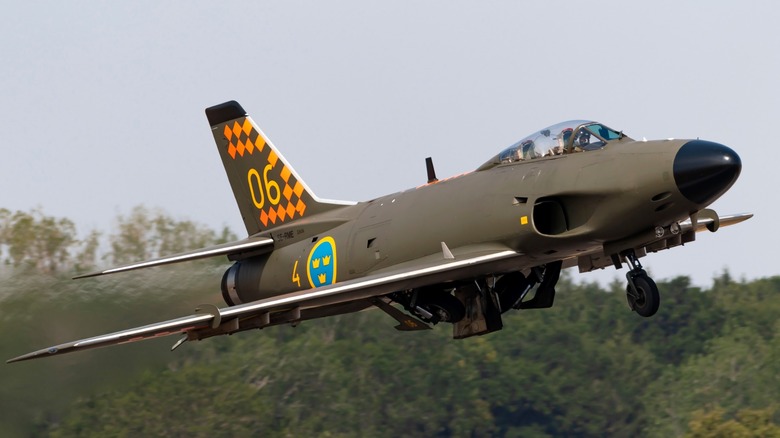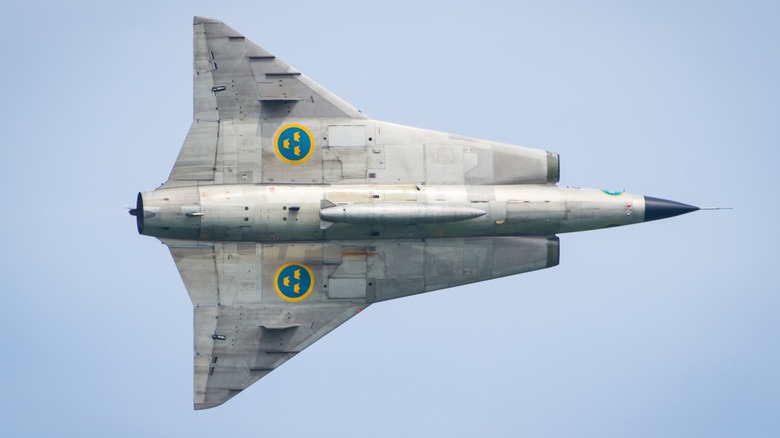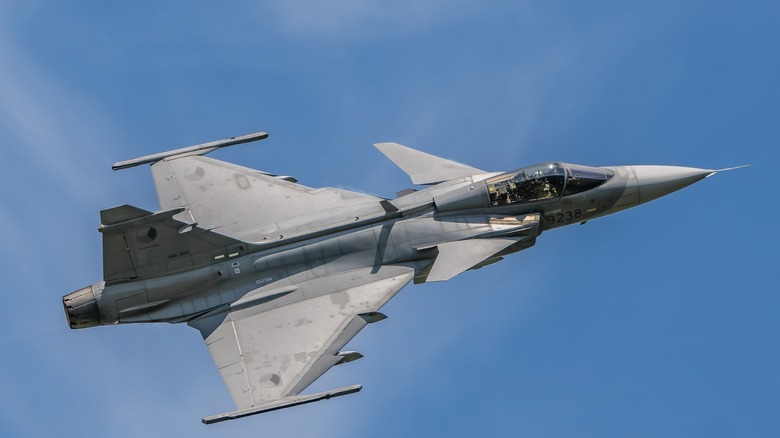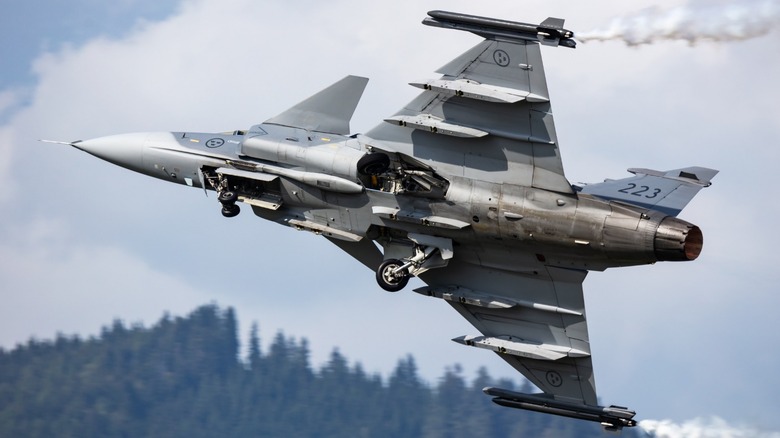5 Of The Coolest Saab Fighter Jets Ever Built
Most people probably remember Saab's distinctive line of cars, but it might surprise you that the company stopped selling consumer vehicles in 2011. Saab AB was originally founded as a Swedish defense and aerospace company on April 2, 1937, but its roots in defense for Sweden date back to the 1600s.
In the mid-1930s, with memories of World War I and the horrors that it brought, Sweden, in an attempt to stay neutral in a potential upcoming conflict, amended its defense policy to strengthen its defenses. In 1936, Swedish Prime Minister Per-Albin Hansson declared that the country should attempt to manufacture advanced military vehicles domestically, including a modern air force that could defend the country if Europe went to war again.
To this end, the country would aim to acquire 297 warplanes and 95 training aircraft for the Swedish armed forces. The company tapped to do this was Svenska Aeroplan Aktiebolaget, better known as Saab. This initial contract would just be the start of what was a long legacy of Saab military aircraft production, leading to the creation of some of the best military jets in the world.
Saab 29
Though the oddly-designed Saab 21R would be Saab's first-ever jet-powered aircraft, the Saab 29, also known as the Tunnan or Barrel, was the true start of Saab's jet fighter excellence. The first swept-wing fighter manufactured in Western Europe, the Saab 29, would take its first flight in 1948 and officially enter service with the Swedish military in 1951.
The Saab 29 fulfilled air-to-air and air-to-ground roles as a fighter and bomber and would be used all the way into the early 1970s. Equipped with a Svenska Flygomotor RM2 turbojet engine, the single-crew plane could reach speeds of up to 659 miles per hour and reach elevations of 45,000 feet.
This would rival the United States' combat jet at the time, the F-86 Sabre, which could reach maximum speeds of 685 miles per hour and had the reputation of being one of the best planes used in the Korean War.
A total of 661 of the jets would be produced, with the final variation of the plane, the J29F, being retrofitted with Svenska Flygmotor RM2B engines with afterburners to increase the jet's power.
Saab 32 Lansen
By the time the Saab 29 entered service with the Swedish Air Force, Saab was already on the cusp of developing a new aircraft, the 32 Lansen. Though not produced in as much quantity as later jet models developed by Saab, the 32 Lansen stands on its own as the first Saab jet to reach speeds faster than the speed of sound.
The two-crew Lansen was initially developed as an attack aircraft, but its purpose would be changed to a fighter and reconnaissance aircraft. The first flight for the Lansen would occur on November 3, 1952. One year later, in 1953, the plane would exceed the speed of sound, though it wouldn't be the first time in the world an aircraft would go that speed, as Bell X-1's rocket aircraft had achieved that milestone in 1947.
Variations of the Lansen, like the S 32C, would be equipped with aerial surveillance cameras and special radar and electronic warfare equipment. In total, 455 Saab 32 Lansens were manufactured, with a few of the planes staying in operation and being used by the Swedish Air Force until 1997.
Saab 35 Draken
The Saab 35 Draken would be the next generation of jet fighters after the Saab 32 Lansen. It would stand as another significant boost in aeronautic technology for the company and serve as Sweden's main fighter and interceptor. Taking its first flight on October 25, 1955, by test pilot Bengt Olow, the Draken would become the new backbone of the Swedish Air Force.
The Saab 35 Draken was an amazing aircraft, as it was the world's first series-produced fighter jet with a double delta wing design. It also stood as Saab's first aircraft capable of reaching Mach 2 speeds (about 1,500 miles per hour) and climbing to 66,000 feet in elevation. Powered by one Svenska Flygmotor RM6C afterburner turbojet engine capable of generating 12,700 pounds of thrust, the Draken was impressive, especially for its time.
In total, over 612 Draken jets would be produced by Saab, with some variation of the plane servicing the military well into the 1990s. In addition to serving as the main jet fighter for Sweden, the plane would also be exported to countries like Denmark, Finland, and Austria.
Saab 37 Viggen
The Saab 37 Viggen, which name means "thunderbolt" or "tufted duck," is a multi-purpose jet fighter developed by Saab during the height of the Cold War in the 1960s. Codenamed Aircraft System 37 in 1963, Saab had finalized the design for the Viggen, which included one pioneering innovation — canards, or a horizontal surface mounted on the fuselage that improves stability. It would become the first mass-produced airplane with canards and go on to inspire other canard-designed jets in the future.
Licening the Pratt & Whitney JT8D jet engine, Saab manufactured a modified version for the Gripen, the Volvo RM8. The RM8, unlike the JT8D, included afterburners and a variable nozzle, enabling the Viggen to reach speeds of 1,386 miles per hour. Notably, the jet also comes with a thrust reverser.
The first flight for a Saab 37 Viggen prototype would occur in 1967, piloted by Erik Dalhstrom, and the Swedish Air Force would continue utilizing the jet until 1994, when Sweden would begin removing them from service. In 2005, the last Viggen would officially retire, replaced by Saab's newest jet, the JAS 39 Gripen.
JAS 39 Gripen
A competitor to the iconic F-15 and F-16 fighter jets, the JAS 39 Gripen, or Griffin, forms the core of Sweden's air arsenal. Like the iconic jet that came before it, the JAS 39 Gripen also utilizes a modified engine. This time, it's a derivative of the F404 turbofan called the RM12, designed in a collaboration between General Electric and Volvo Aero.
The first prototypes and production aircraft for the JAS 39 Gripen would occur in 1988, with a second batch of 110 aircraft being ordered a few years later in 1992. After a few initial testing road bumps, the jet would officially enter service for the Swedish military.
Though based on sheer speed and stats, the Gripen doesn't appear to be a big upgrade from the Viggen, the JAS 39 Gripen is incredibly light, small, and mobile, as it maintains the tradition of being a one-seat, one-engine jet. Able to take off and land with incredibly short runways, the size of the jet enables it to be more maneuverable & versatile — with the ability to scramble from smaller bases quickly.
The latest iteration of the jet, the Saab Gripen E-series, integrates the latest cutting-edge military technology into the plane, including updated sensors, AESA-radar, an InfaRed Search and Track System, and advanced weaponry. In addition, the E-series comes equipped with a more powerful engine, the GE F414G, which is also used in the F-18 Super Hornet.
